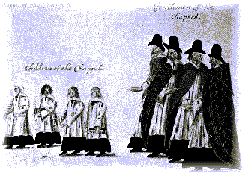|
The
St Thomas Singers
conductor Donald Halliday
Martin
Charlton organ
Kings
Hall, University of Newcastle
Saturday 22 February 1997, 7.30 pm
The
Glories of the Chapel
presented as part of the first Newcastle Early Music Festival
Programme
Tye
O come ye servants of the Lord
Parsons Ave Maria
Organ: Byrd Clarifica me pater
Byrd
Ave verum Corpus
Byrd Teach me, O Lord
Byrd Haec Dies
Tallis If ye love me
Organ: Tallis Hymn: Veni Redemptor
Tomkins When David heard
Gibbons Almighty and everlasting God
Gibbons O clap your hands
Gibbons The silver swan
Morley Sing we and chaunt it
Morley Now is the month of maying
and from The Triumphes of Oriana
Morley Hard by a cristall fountaine
Bennet All creatures now
Weelkes As Vesta was from Latmos hill descending
The
records of the Chapel Royal can be traced back to 1135. It visited
York in 1200 with King John, and in 1418 it was summoned to Bayeux
for Henry V's Easter celebrations. By the 16th century Henry VIII
had luxuriously endowed the Chapel with a musical staff of some
seventy-nine musicians.
During
the reign of Elizabeth I (1558 - 1603) the Chapel Royal became the
glory of the civilised world. Composers of the calibre of Tye, Tallis,
Byrd, Gibbons, Morley and Tomkins were writing music of a quality
which was not surpassed anywhere else in Europe. These composers
also perfected the English madrigal, and significantly developed
the art of keyboard playing.
That
impressive tradition died with the fall of the monarchy in 1649
when the Chapel was disbanded. With the restoration of the monarchy
in 1660 the Chapel Royal enjoyed a brief resurgence when Charles
II employed Henry Purcell to provide music which could rival that
of Louis XIV's court in France. However, that revival was brief,
and under later monarchs the fortunes of the Chapel started to decline.
This
evening's programme celebrates the golden age of the Chapel Royal
with performances of religious and secular music by musicians who
were (mostly) in the employ of the Chapel Royal during the reign
of Queen Elizabeth I.
|

